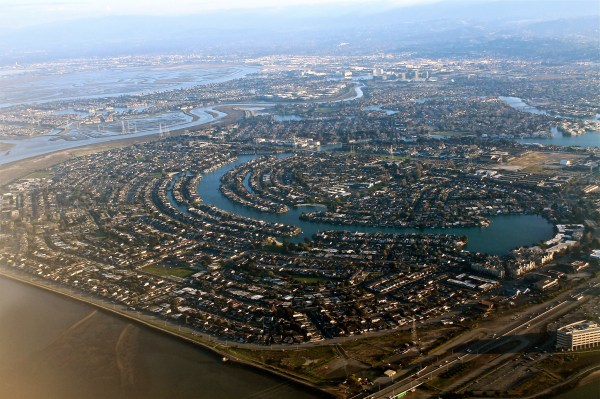Another TechCrunch Disrupt has come and gone. And once again we’re back to waiting in our traffic jams, overpaying for our lunches, and commuting to and from our siloed campus companies.
Or we fly into old-looking airports and overpay for hotels.
Is this the urban architecture of the future?
Could public goods offered in places like Singapore and Shanghai (or even New York) make The Valley cheaper, even more creative and attract more money?
For the last 3-4 years, my colleagues and I have analyzed ways of improving urban agglomerations like Silicon Valley (and its proto-valley cousins abroad).
We all know – thanks to the likes of Richard Florida, John Kasarda & Greg Lindsay and Edward Glaeser — that denser cities bring advantages than spread-out valleys can’t.
Silicon Valley may incubate great ideas – but it still needs the might of New York, London and Hong Kong to scale.
New York and Chicago (and their cousins Singapore, Hong Kong and Shanghai) exist as legal entities with governments and businesses investing in them.
Yet “Silicon Valley” only exists as a metaphor – with loose associations like the Joint Venture Silicon Valley to look after it. Who can provide the informal clustering of cities (from South San Francisco to San José) with trains, planes, linked-up offices, and other amenities that make city life better?
The urban cluster we call New York didn’t just pop into existence – as a visit to the boroughs and outbacks of the Wall Street’s home – can attest to. The strong hands of the state molded urban agglomerations like New York, Hong Kong and Singapore into existence.
Silicon Valley can have an identity above and beyond the San Mateo-Menlo Park-Mountain View-Santa Clara-Palo Alto-San Jose grouping. But the Valley’s city ordinances can’t be woven into a fabric needed to provide social goods like airport expansion, public transport, and urban planning to link-up large buildings. State law can’t wave a functional Silicon Valley (operating as an integrated area) into being.
Yet, behind every great urban center lies a great urban authority. Why doesn’t Silicon Valley have its own large-scale authority? A Silicon Valley Development Authority.
One part Tennessee Valley Authority, one part China Development Bank, such an authority would have the power to wrestle authority and money from state and city alike. Silicon Valley companies could own shares in the Authority – thus keeping political power and profiting at the same time. Governments could also hold shares, and certainly provide oversight over an authority able to treat the entire Valley like a political and administrative start-up.
A Silicon Valley Development Authority could add an extra $20-$25 billion in output per year if it plays its cards right. Such an authority would raise much needed tax revenue by around $3-5 billion per year – making it popular with governments.
Such extra output, according to our modeling, comes from three sources.
First, the Authority would provide money and organizational wherewithal to get more trains, planes and light infrastructure on the ground – reducing commuting times and car expenses.
Second, the Valley’s companies could invest in denser working areas without sacrificing its green campuses. Indeed, a bit more density could reduce Silicon Valley’s footprint, saving land, water and electricity.
Third, a bit more density around San Jose could bring networking and other intangible benefits than Richard Florida and Edward Glaeser show come with real cost of living and salary benefits. A bit more apartment living and train-riding (and a bit fewer suburban houses and cars) might make life cheaper for the Ramen crowd as well.
 Designing a real Silicon Valley – not just the figment of journalist Don Hoefler’s imagination – comes with challenges. Authorities will need to be transferred (some even from the federal level). The Authority’s mandates need to be negotiated with governments and tech company investors alike. Existing political groups will need to be bought-off with future benefits. We are refining our calculations about the way such an Authority might impact on these groups.
Designing a real Silicon Valley – not just the figment of journalist Don Hoefler’s imagination – comes with challenges. Authorities will need to be transferred (some even from the federal level). The Authority’s mandates need to be negotiated with governments and tech company investors alike. Existing political groups will need to be bought-off with future benefits. We are refining our calculations about the way such an Authority might impact on these groups.
Yet, imagine if your children one day looked at the local version of Singapore’s City Gallery, and saw how design (a core principle in the Valley) helped improve the code governing urban life.
Over 40 years of experience shows that “public goods” can earn a solid profit. When development authorities own some of the land they develop infrastructure on, they gain higher rents, taxes and real estate price appreciation to boot.
Paying market-price-plus-a-very-very-nice-profit to take public transport to Draper University or Y Combinator’s headquarters is still cheaper than buying and running a car for many. Many holders of companies floated by governments or these development authorities made very high profits in the longer-term. Enough venture funding alone exists in the Valley to try this much-needed social venture.
Silicon Valley’s companies have often talked about their desire to influence and reform Washington. Isn’t it time they start by innovating their own self-rule?
